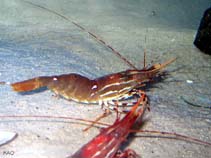Pandalus platyceros Brandt, 1851
Spot shrimp| Native range | All suitable habitat | Point map | Year 2050 |

|
| This map was computer-generated and has not yet been reviewed. |
| Pandalus platyceros AquaMaps Data sources: GBIF OBIS |
رده بندی / Names اسامي عام | مترادف | CoL | ITIS | WoRMS
Malacostraca | Decapoda | Pandalidae
Environment: milieu / climate zone / تغييرات عمق / distribution range بوم شناسي
; تغييرات عمق 0 - 2648 m (مرجع 91801), usually 45 - 234 m (مرجع 91824). Temperate; 60°N - 27°N, 167°W - 113°W
Distribution كشورها | مناطق سازمان خوار و بار جهاني (FAO) | Ecosystems | ظهور | معرفي
Eastern Pacific: The west coast of north America from Unalaska Island to Kachemak Bay and Prince William Sound south to Punta Eugenia, Baja California Sur, Mexico.
Length at first maturity / Size / Weight / سن
بلوغ: Lm ? range ? - ? cm Max length : 30.0 cm TL جنس نر / بدون خواص جنسي; (مرجع 91741); بيشينه وزن گزارش شده: 120.00 g (مرجع 91741); بيشينه سن گزارش شده: 6 سال ها (مرجع 104007)
توصيف مختصر ريخت شناسي
Life cycle and mating behavior بلوغ | تولید مثل | تخم ریزی | Eggs | Fecundity | Larvae
مآخذ اصلی
مراجع | هماهنگ كننده | همكاران
Butler, T.H. 2011 Growth, reproduction, and distribution of pandalid shrimps in British Columbia. J. Fish. Res. Board Can. 21(6):1403-1452. (مرجع 91750)
وضعيت در فهرست قرمز IUCN
(مرجع 130435: Version 2025-1)
وضعيت از نظر سايتس (مرجع 108899)
CMS (مرجع 116361)
خطر برای انسان ها
استفاده انسانی
ماهي گيري – شيلات: تجاري
| FishSource |
ابزارها
اطلاعات بيشتر
منابع اينترنتي
BHL | BOLD Systems | CISTI | DiscoverLife | FAO(Publication : search) | Fishipedia | GenBank (ژنوم, نوکلئوتيد) | GloBI | Gomexsi | Google Books | Google Scholar | Google | PubMed | Tree of Life | Wikipedia (برو, جستجو) | Zoological Record



